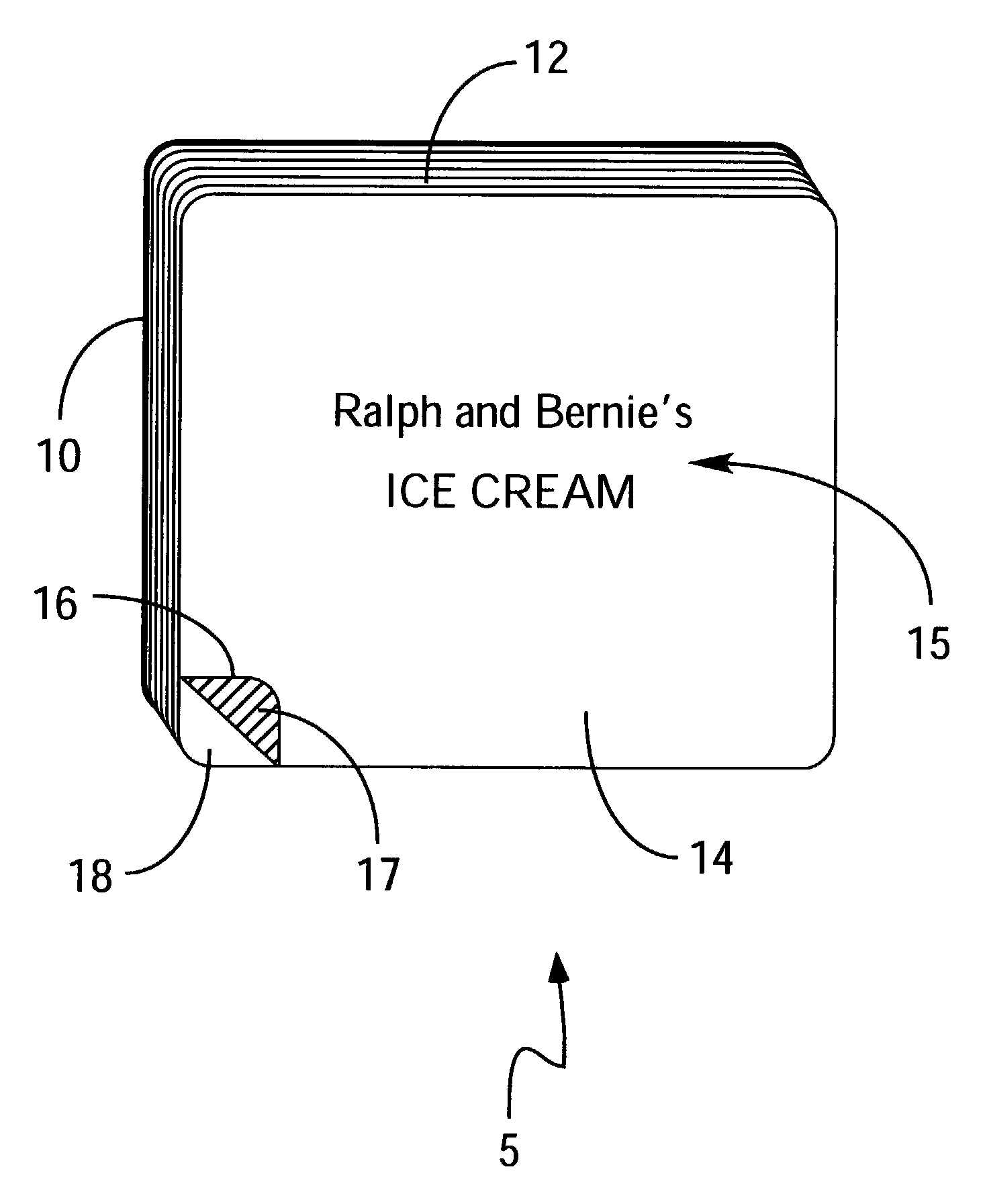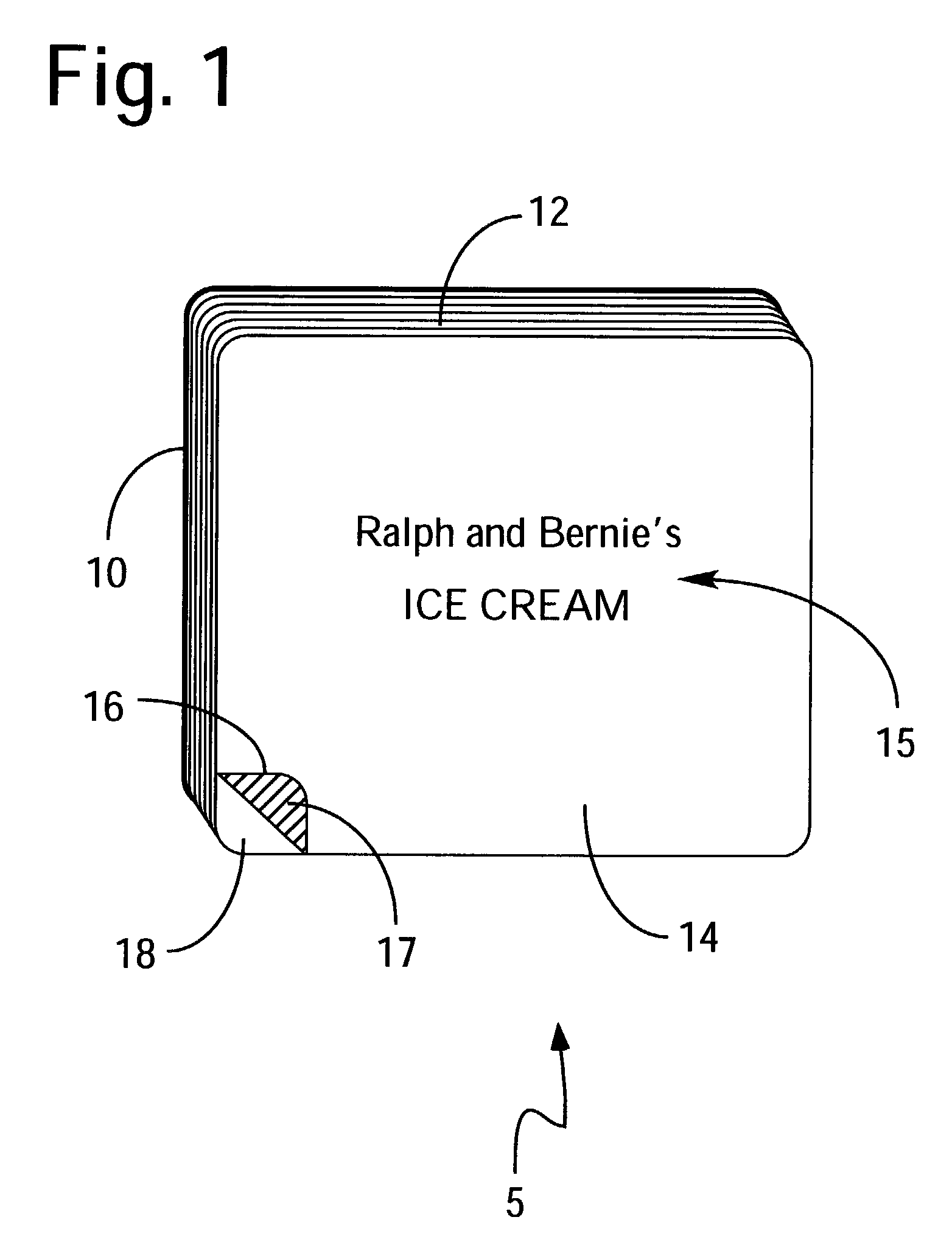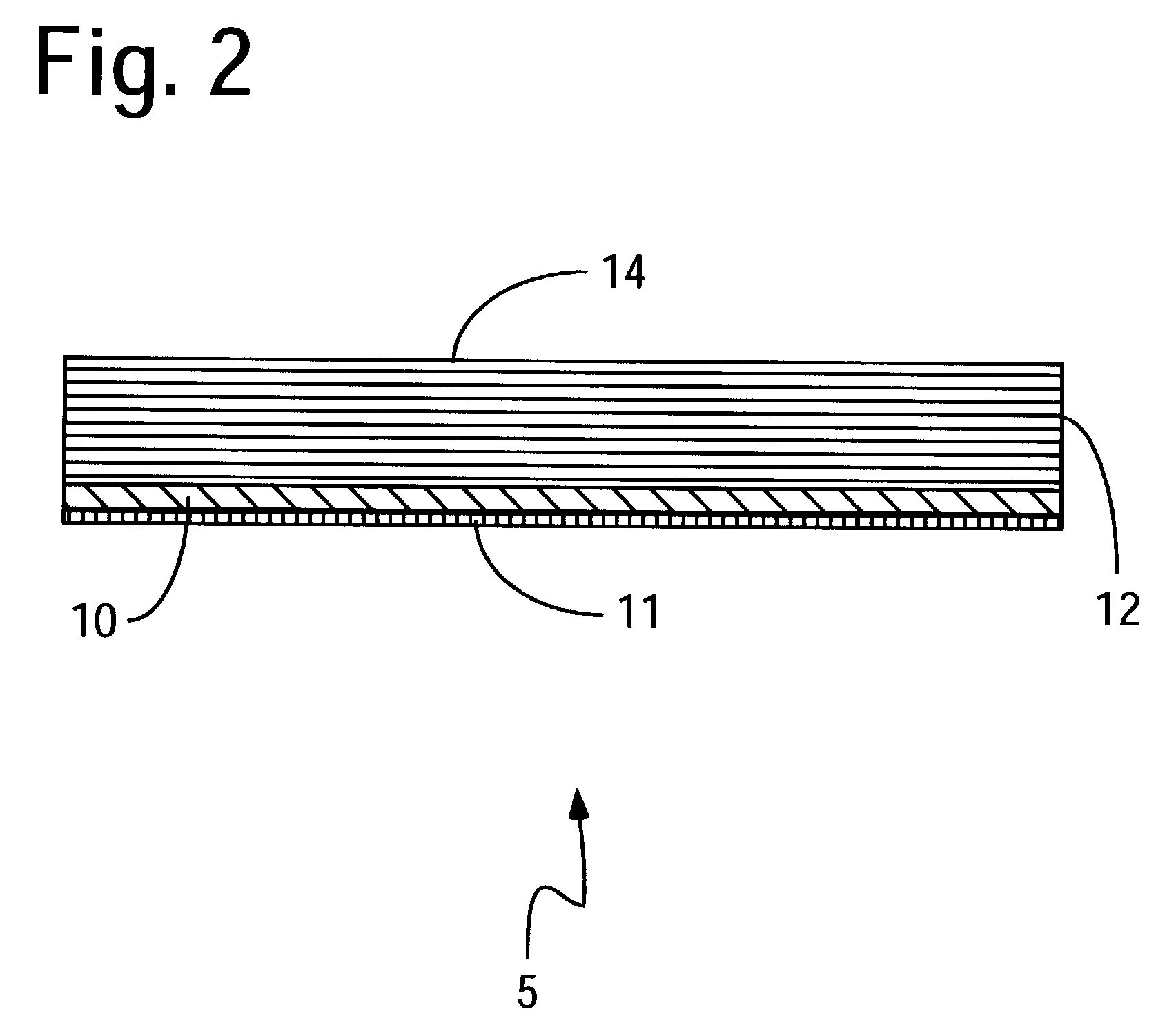[0021]Each of the detachable plies is constructed of paper having an offset weight of approximately 70 pounds. In addition to its weight, the paper has adequate tensile strength to withstand deformation forces imposed by movement of the track ball roller, even when it is supported by
adhesive covering substantially the entire undersurface of each layer, including the layer located immediately above a rigid base. The base of the ply comprises a paper composition similar to that conventionally used for most note-taking paper pads. For increased stability, the base is additionally provided with a non-skid under surface. Generally, the number of tracking surfaces exceeds several plies and ranges upward into the mid-teens. The maximum number of plies utilized depends on the strength and thickness of the sheets of paper, the thickness of the
adhesive and the support structure provided by the combination of the paper sheets and the
adhesive layer. The surface of each sheet that opposes the adhesive
coated surface is provided with an adhesive release
coating, which additionally functions to enhance the appearance of the surface. The adhesive release
coating operates to decrease damage to the sheet brought about by swelling or buckling, which is oftentimes created by
moisture absorption and other environmental conditions. The coating further operates to minimize the accumulation of dust, stains, carbon or
graphite material, and the like. It enhances the overall ability of the upper surface to maintain proper tension, thereby facilitating roller
ball tracking movement.
[0022]Each of the plies is, optionally, provided with printed material on its uppermost surface. Through an on-press or off-press application, each ply is further provided with a protective
spray coating to enhance surface quality. This spray
coated surface layer is transparent so that the printed material could be easily seen and also functions as a release layer and a
moisture barrier. A
pile binding is typically effected in the manner employed for note-taking pads. The binding can be applied on one or more sides of the pad.
[0023]Adhesion of the plies can be achieved by coating a substantial portion of the undersurface of each ply, to provide sufficient tackiness that the plies are stabilized against movement in virtually any direction without compromising removability. Advantageously, with this embodiment, stabilization is markedly improved without need for application of binding to one or more sides of the pad. Process costs associated with the binding step are decreased and replenishment of the upper sheet is facilitated.
[0024]In one embodiment, the entire undersurface of the sheet may be coated with the adhesive layer. In a second embodiment, the adhesive coating may be applied as a closely spaced series of circles or rectangles, so that the top layer is prevented from horizontal motion when the track ball is rolled. This spacing sensitively depends on (1) the tensile strength of the sheet of paper, which is controlled by the
fiber length of the paper; (2) the
bulk density of the paper (herein defined as the distance between the fibers and the
resultant hydrogen bond); and (3) the thickness of the adhesive layer. Since the adhesive layer deforms freely under load, it is preferable to minimize the thickness of the adhesive layer as compared to the thickness of the paper. It is also desirable to use paper having higher tensile strength, so that they can withstand the forces applied by the track ball. The requirements described hereinabove are less critical when the underside of the paper sheets is completely covered by a thin adhesive layer. One or more adhesive areas, such as adhesive spots applied from the binding side of a
pile, can be applied to the under surface of each ply to improve adhesion of the upper ply to the ply below it, and thereby stabilize the plies against transverse movement during use.
[0025]More specifically, the invention provides a computer mouse pad comprising a rigid base and a stack of sheets of paper detachably fixed to the base. Each sheet of the stack is detachably fixed to the sheet below it. The stacked sheets are provided with printed messages on upper surfaces thereof. An upper sheet is removed when worn or soiled, thereby exposing the next sheet in the stack and its message, for use as the upper surface of the mouse pad. The coated upper surface is resistant to being written upon except in specific locations, where the mouse track ball is not expected to contact, thereby preventing accumulation of carbon,
graphite, ink, and the like, which tend to contaminate the roller ball, prevent proper mouse tracking and adversely affect curser control. This coating also acts as a
moisture barrier, preventing the swelling of the top most
paper sheet; and as a release layer to allow the sheet to be detached readily from the adjoining sheet.
[0026]Advantageously, the
pile with detachable plies provides means for regenerating fresh
usable surfaces, one surface at a time, as surfaces become degraded in appearance or mouse tracking capability. The pile also provides means for displaying printed information helpful to the computer user, such as application shortcuts, tips, and the like. Printed information additionally displayed by the pile can comprise decorative configurations, such as color pictures of flower bouquets, landscapes or patterns, calendar images and other presentations, including advertising. Detached plies can be displayed apart from the pad, scanned into memory or otherwise saved, or discarded, in accordance with user preferences. The mouse pad appearance can be refreshed by providing a newly exposed ply having the same presentation as the previous ply. Refreshing the ply appearance can be encouraged by displaying on successive pages a plurality of differing, self-contained printed images that provide continuity. An incentive for timely refreshment of the ply appearance can also be engendered by provision of a mouse pad in which the information conveyed by successive ply removal creates a serial affect.
 Login to View More
Login to View More  Login to View More
Login to View More 


